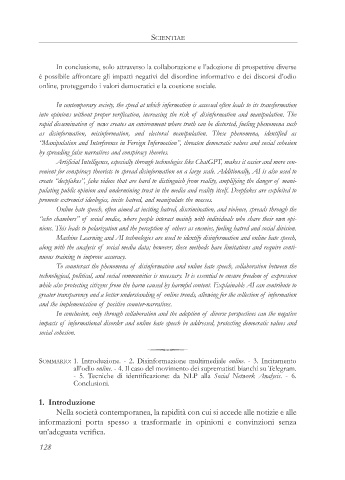Page 130 - Rassegna 2024-2
P. 130
SCIENTIAE
In conclusione, solo attraverso la collaborazione e l’adozione di prospettive diverse
è possibile affrontare gli impatti negativi del disordine informativo e dei discorsi d’odio
online, proteggendo i valori democratici e la coesione sociale.
In contemporary society, the speed at which information is accessed often leads to its transformation
into opinions without proper verification, increasing the risk of disinformation and manipulation. The
rapid dissemination of news creates an environment where truth can be distorted, fueling phenomena such
as disinformation, misinformation, and electoral manipulation. These phenomena, identified as
“Manipulation and Interference in Foreign Information”, threaten democratic values and social cohesion
by spreading false narratives and conspiracy theories.
Artificial Intelligence, especially through technologies like ChatGPT, makes it easier and more con-
venient for conspiracy theorists to spread disinformation on a large scale. Additionally, AI is also used to
create “deepfakes”, fake videos that are hard to distinguish from reality, amplifying the danger of mani-
pulating public opinion and undermining trust in the media and reality itself. Deepfakes are exploited to
promote extremist ideologies, incite hatred, and manipulate the masses.
Online hate speech, often aimed at inciting hatred, discrimination, and violence, spreads through the
“echo chambers” of social media, where people interact mainly with individuals who share their own opi-
nions. This leads to polarization and the perception of others as enemies, fueling hatred and social division.
Machine Learning and AI technologies are used to identify disinformation and online hate speech,
along with the analysis of social media data; however, these methods have limitations and require conti-
nuous training to improve accuracy.
To counteract the phenomena of disinformation and online hate speech, collaboration between the
technological, political, and social communities is necessary. It is essential to ensure freedom of expression
while also protecting citizens from the harm caused by harmful content. Explainable AI can contribute to
greater transparency and a better understanding of online trends, allowing for the collection of information
and the implementation of positive counter-narratives.
In conclusion, only through collaboration and the adoption of diverse perspectives can the negative
impacts of informational disorder and online hate speech be addressed, protecting democratic values and
social cohesion.
!
SOMMARIO: 1. Introduzione. - 2. Disinformazione multimediale online. - 3. Incitamento
all’odio online. - 4. Il caso del movimento dei suprematisti bianchi su Telegram.
- 5. Tecniche di identificazione: da NLP alla Social Network Analysis. - 6.
Conclusioni.
1. Introduzione
Nella società contemporanea, la rapidità con cui si accede alle notizie e alle
informazioni porta spesso a trasformarle in opinioni e convinzioni senza
un’adeguata verifica.
128

